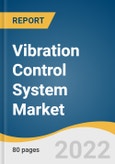The global vibration control system market size is expected to reach USD 7.93 billion by 2030, registering a CAGR of 6.2% over the forecast period. Growing adoption of vibration control systems in healthcare applications is expected to drive market growth over the forecast period. Vibration control systems are being used in healthcare applications to mitigate the impacts of vibration on sensitive equipment such as DNA sequencing microarrays and Magnetic Resonance Imaging (MRIs).
Vibration Control Systems (VCS) are also extensively used in the aerospace & defense industry to decrease the vibrations causing damage to the aircraft windshield, windowpanes, doors, and shipments. Based on system type, the market is segmented into motion control and vibration control systems. The demand for motion control systems in automotive, power plants, and the oil & gas industry has increased over the last few years. Motion control systems isolate the effects of vibration and shock in power plants, thereby increasing the demand for such systems among these industries.
Besides, the electronics & electrical industry, including industrial goods, is witnessing a paradigm shift in terms of increasing usage of vibration control methods. Vibration control systems are used in the industrial goods industry for isolating vibrations on electronic instruments and measuring equipment. Additionally, another factor contributing to the substantial growth of this region is the presence of major manufacturers in the Chinese regional market. The low cost of capital and availability of cheap labor & material in this region is expected to drive the growth of the market.
This product will be delivered within 1-3 business days.
Vibration Control Systems (VCS) are also extensively used in the aerospace & defense industry to decrease the vibrations causing damage to the aircraft windshield, windowpanes, doors, and shipments. Based on system type, the market is segmented into motion control and vibration control systems. The demand for motion control systems in automotive, power plants, and the oil & gas industry has increased over the last few years. Motion control systems isolate the effects of vibration and shock in power plants, thereby increasing the demand for such systems among these industries.
Besides, the electronics & electrical industry, including industrial goods, is witnessing a paradigm shift in terms of increasing usage of vibration control methods. Vibration control systems are used in the industrial goods industry for isolating vibrations on electronic instruments and measuring equipment. Additionally, another factor contributing to the substantial growth of this region is the presence of major manufacturers in the Chinese regional market. The low cost of capital and availability of cheap labor & material in this region is expected to drive the growth of the market.
Vibration Control System Market Report Highlights
- The market is anticipated to witness substantial growth during the forecast period, owing to the rising adoption in various industries, including healthcare, oil & gas, and aerospace & defense, among others.
- The vibration control segment accounted for the highest revenue share in 2021, owing to the growing demand for automation controls in power plants and oil & gas industries.
- The manufacturing industry is expected to register the highest growth over the forecast period, owing to the rapidly increasing manufacturing of industrial machinery worldwide.
- Europe held the largest revenue share in 2021, owing to the presence of a large number of automobiles manufacturers in the region.
This product will be delivered within 1-3 business days.
Table of Contents
Chapter 1. Methodology and Scope
Chapter 2. Executive Summary
Chapter 3. Market Variables, Trends, and Scope Outlook
Chapter 4. Vibration Control Systems Type Outlook
Chapter 5. Vibration Control Systems Application Outlook
Chapter 6. Vibration Control Systems Regional Outlook
Chapter 7. Competitive Landscape
Companies Mentioned
- Contitech AG
- Lord Corporation
- Resistoflex
- Hutchinson
- Fabreeka
- Sentek Dynamics Inc.
- Vicoda GmbH
- Isolation Technology Inc.
- Trelleborg Ab
- Kinetics Noise Control, Inc.
Methodology

LOADING...
Table Information
| Report Attribute | Details |
|---|---|
| No. of Pages | 80 |
| Published | April 2022 |
| Forecast Period | 2022 - 2030 |
| Estimated Market Value ( USD | $ 4.9 Billion |
| Forecasted Market Value ( USD | $ 7.93 Billion |
| Compound Annual Growth Rate | 6.2% |
| Regions Covered | Global |
| No. of Companies Mentioned | 10 |









